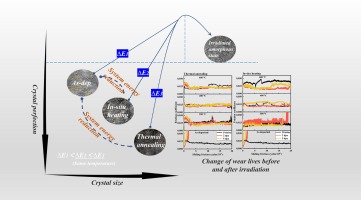Abstract
Previous works prove that the MoS2 films with nanocomposite structure subject to several dpa heavy ion irradiation damage show degradation of tribological properties, however vacuum annealing at 600 ? can significantly promote the irradiation tolerance of deposited MoS2 films. To study the influence of the temperature on the irradiation resistance of MoS2 film, both vacuum annealing and in situ heating methods were used to prepare nanocomposite MOST (MoS2/Ti) films. The results show that the MOST films annealed above 200 ? exhibits good irradiation resistance. And comparable irradiation tolerance appears in MOST films deposited by in situ heating above 400 ?. In both cases, the irradiation resistance of MOST films comes from the reduction of initial defects. Grain nucleation and growth are larger and more perfect benefit from the long time thermal annealing process, while in the case of in situ heating deposition, the grain nucleation and film growth are carried out and the two processes limit each other at the same time, the two processes conflict, so the irradiation resistance of MOST film can only be improved at a relatively higher temperature.

Keywords Plus:TRIBOLOGICAL PROPERTIESCOMPOSITE COATINGSCONCEPTUAL DESIGNMOS2MICROSTRUCTUREMAINTENANCETEMPERATUREBEHAVIOR
Published in Volume605;10.1016/j.apsusc.2022.154622,DEC 15 2022


